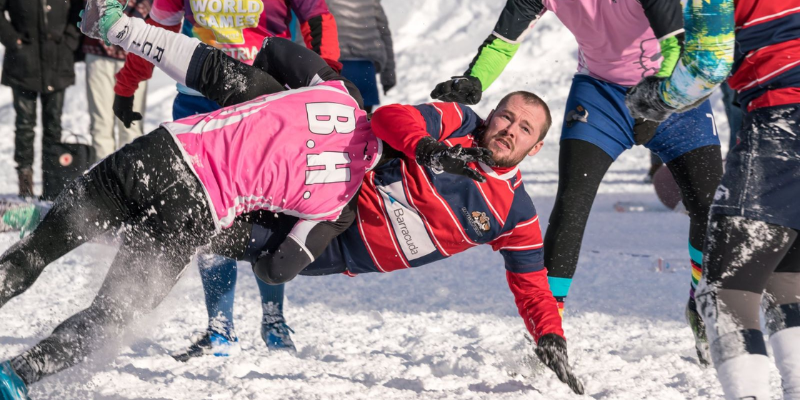Snow rugby is a cool version of rugby union played in winter.
Unlike regular rugby on grass, snow rugby is played in icy conditions with deep snow.
Rules of Rugby in Snow
- Pitch: This rugby is typically played on a snow-covered field, which can be a natural snowy surface or a specially prepared area. The dimensions of the pitch may vary, but it generally follows rugby union standards.
- Teams: These special rugby teams consist of 7 players each (similar to rugby sevens). There are men’s, women’s, and mixed-gender categories.
- Attire: Players wear appropriate winter gear, including thermal clothing, gloves, and snow boots. Cleats are not suitable for snow rugby, so players opt for footwear that provides better traction on icy surfaces.
- Ball: A standard rugby ball is used, but ice can make it slippery. Players adapt their handling techniques accordingly.
- Scoring: The objective remains the same as in regular rugby: score tries (touchdowns) by crossing the opponent’s try line. Conversions and penalty kicks are also part of the game.
- Adapted Rules of Rugby in Snow:
- Scrums: Traditional scrums can be challenging in deep snow. Instead, a “snow scrum” involves players binding together and pushing against each other.
- Lineouts: Lineouts are modified to accommodate the snowy conditions. Players lift their teammates to contest for the ball.
- Tackling: Tackles are gentler on hard snow to avoid injury. Players slide into tackles rather than execute full-force hits.
How do you Start Playing Rugby in the Snow?

- Kickoff: This rugby match begins with a kickoff from the center of the field. The receiving team aims to catch the ball and launch their attack.
- Running and Passing: Players adapt their running style to the slippery surface. Passing the ball requires precision, as snow can affect its trajectory.
- Tackling and Rucking: Tackles are executed carefully to prevent injuries. Rucks (when players contest for the ball on the ground) happen, but players need to dig through the snow to secure possession.
- Scoring: Teams strive to score tries by advancing the ball across the try line. Conversions (kicking the ball through the posts after a try) and penalty kicks are also part of the game.
- Strategy: Teams adjust their strategies based on the snow conditions. Quick passes, support play, and maintaining possession become crucial.
- Spectators: Fans cheer from the sidelines, bundled up in warm clothing. The snowy backdrop adds to the spectacle.
Origins and Locations of Snow Rugby
- Canada: The Great White North hosts this kind of rugby, where players tackle and scrum in the midst of snowdrifts.
- Kashmir, India: The picturesque Kashmir region also witnesses this rugby matches.
- Baltic States: Countries like Latvia and Finland embrace this winter sport.
- Russia: From Moscow to the frosty expanses of Siberia, Russian rugby enthusiasts brave the cold.
- United States: Northern states like Minnesota and Alaska join the sport’s fun.
- Argentina: Even the Argentinian Ski Resort of Las Leñas sees these sports players trading cleats for snow boots1.
Safety Measures

- Appropriate Clothing:
- Dress in warm layers to combat the cold. Thermal clothing, gloves, and snow boots are essential.
- Protect your head and ears with a snug hat or headband.
- Wear moisture-wicking fabrics to keep sweat away from your skin.
- Footwear:
- Avoid cleats: Traditional rugby cleats are not suitable. Opt for footwear with better traction on icy surfaces.
- Insulated snow boots or hiking boots work well.
- Hydration and Nutrition:
- Cold weather can lead to dehydration. Stay hydrated by drinking water or warm beverages.
- Consume energy-rich foods to maintain stamina during the game.
- Warm-Up and Stretching:
- Cold muscles are prone to injury. Perform a thorough warm-up before playing.
- Focus on dynamic stretches to increase blood flow and flexibility.
- Visibility:
- Falling snow can reduce visibility. Wear tinted goggles to protect your eyes and improve vision.
- Communicate clearly with teammates to avoid collisions.
- Tackling Techniques:
- Modify your tackling style: Sliding tackles are safer on hard snow.
- Aim for the midsection to avoid high impacts.
- Snow Conditions:
- Be aware of uneven patches, hidden obstacles (like rocks or tree roots), and icy spots.
- Adjust your movements accordingly.
- Cold Hands and Feet:
- Keep your extremities warm.
- Wiggle your toes periodically to maintain circulation.
- Emergency Preparedness:
- Know the location of medical facilities or emergency services.
- Carry a basic first aid kit.
- Sportsmanship and Respect:
- Respect opponents and officials.
- Celebrate the spirit of the game, even in challenging conditions.
Conclusion
Snow rugby is a captivating variant of rugby union played on snow-covered fields. Teams adapt to icy conditions, donning warm gear and adjusting their strategies.
The game follows similar rules to regular rugby, but the snowy environment adds an exciting twist. Safety measures are in place, making it a fun way to experience rugby in a winter wonderland.
F.A.Q
What is rugby in the snow❓
This game is played on snow-covered pitches. It’s a thrilling adaptation of the traditional game, with players navigating icy conditions.
Where is popular rugby in the snow❓
It has gained popularity in regions with cold climates, such as Russia. Tournaments are held on specially prepared snow pitches.
How is this rugby different from regular rugby❓
Snow rugby follows similar rules to regular rugby, but the playing surface and weather conditions add an exciting twist. Players adapt their strategies to the snow and ice.
What gear do snow rugby players use❓
Players wear specialized footwear with better traction for snowy surfaces. They also bundle up to stay warm during matches.
Can anyone play rugby in the snow❓
✅ Yes! It encourages participation from all skill levels. It’s a fun way to experience rugby in a winter wonderland.





